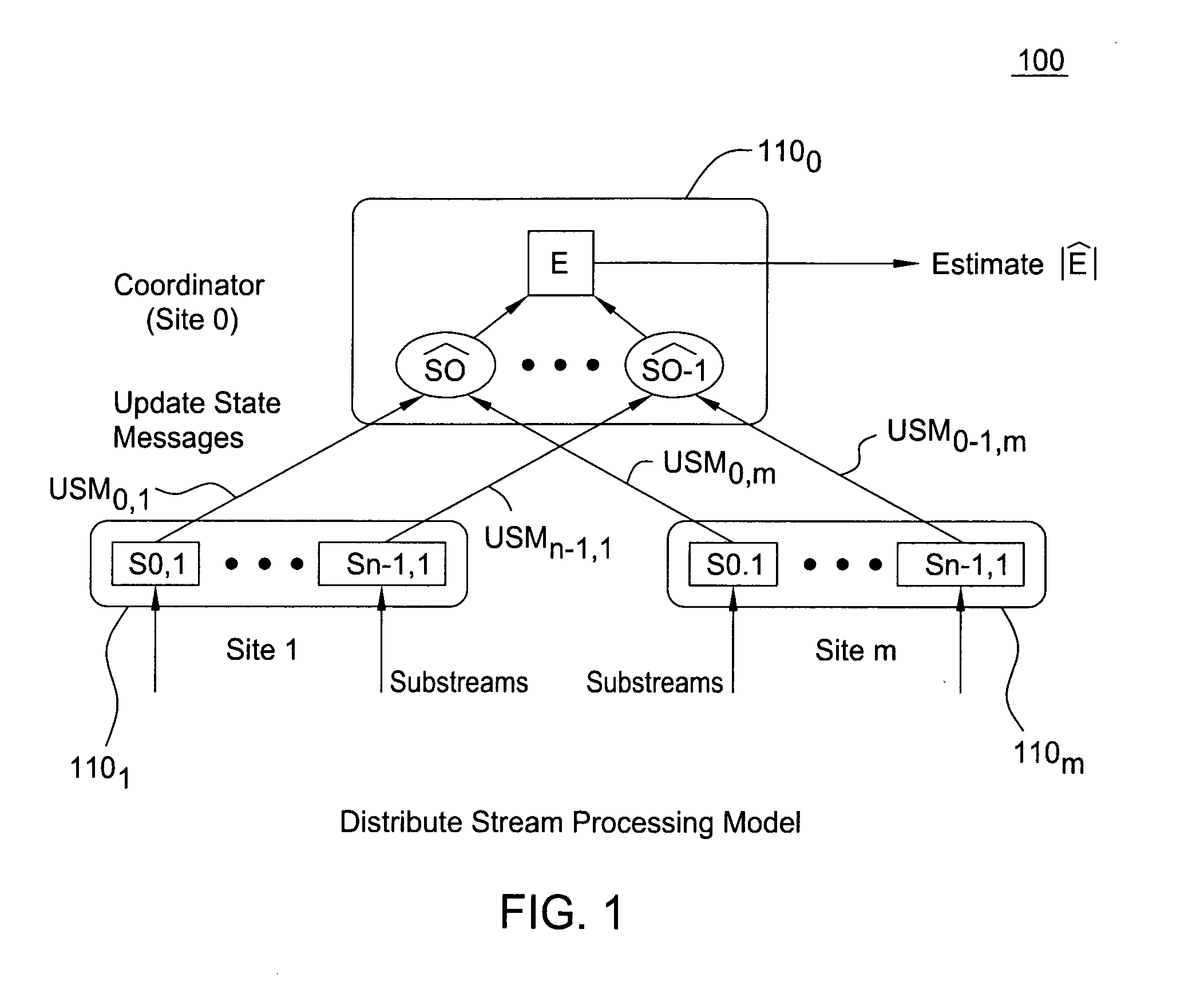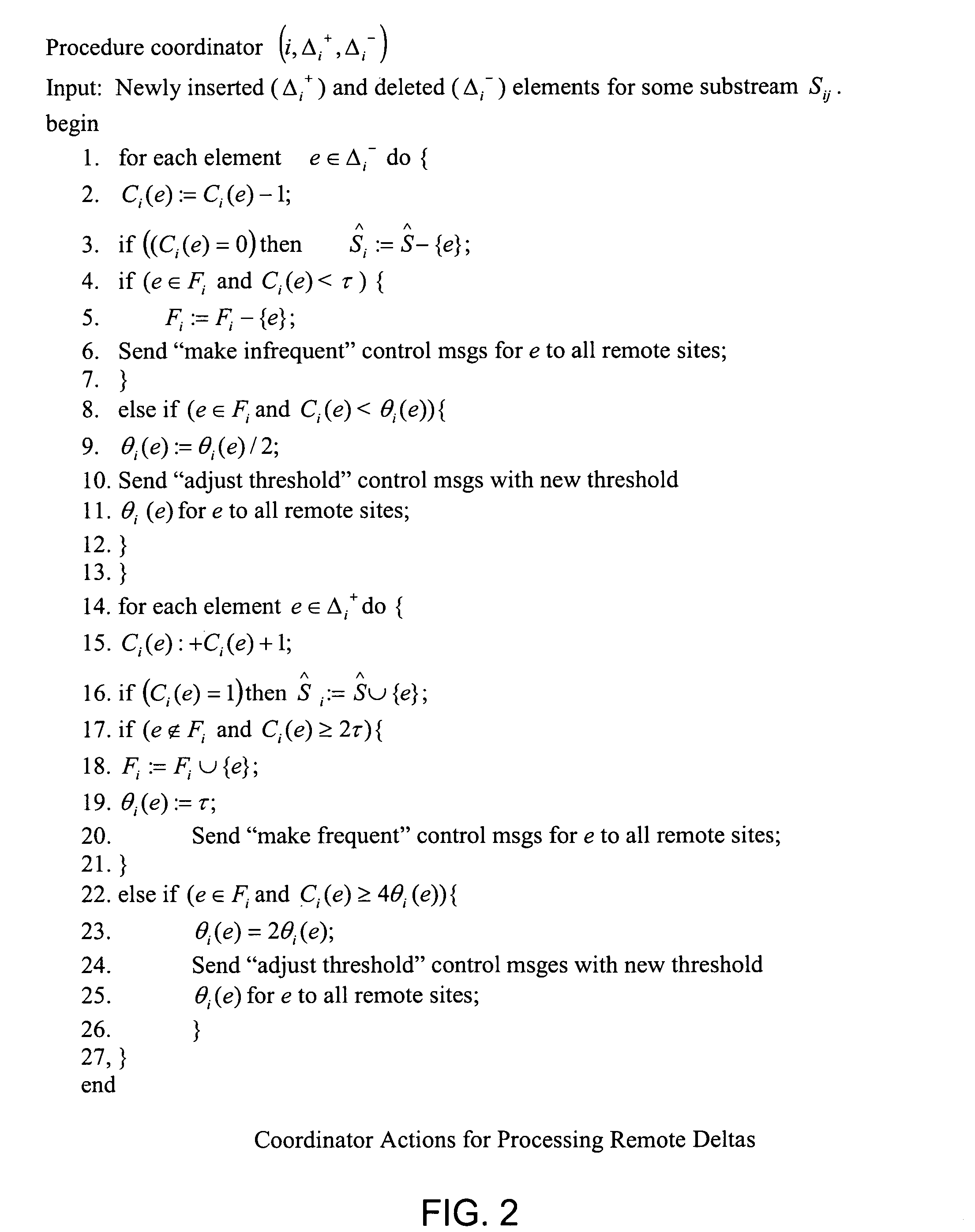Distributed set-expression cardinality estimation
a set-expression and estimation technology, applied in the field of information processing systems, can solve the problems of crippling the communication infrastructure as well as the central site processor, inordinate message traffic, etc., and achieve the effects of reducing data communication costs, reducing the transmission of element state information, and ensuring accuracy
- Summary
- Abstract
- Description
- Claims
- Application Information
AI Technical Summary
Benefits of technology
Problems solved by technology
Method used
Image
Examples
example 1
[0073] Consider distributed streams S1,S2, and S3, and let expression E=S1∩(S2−S3). For element e at site j, let e∈Ŝ3,j and e∈S3,j. Clearly, e∈Ŝ3 and e∈S3, and thus e∉Ê and e∉E. As a result, even if e∈(Ŝ1,j−S1,j) or e∈(S2j−Ŝ2,j), the methodologies should not charge for element e at site j since e cannot possibly be in either E−Ê or Ê−E; thus, based on the semantics of expression E, setting the charges φj+(e)=φj−(e)=0 will still ensure correctness.
[0074] As will be discussed below, for an arbitrary set expression E, the methodologies focus on the problem of computing the minimum possible charges φj+(e) and φj−(e) for a fixed element e at site j by leveraging the semantics of expression E. The various charging schemes ensure that charges φj+(e) and φj−(e) satisfy Equations (1) and (2), and thus provide an accuracy guarantee of ε for the final estimate |Ê|.
[0075] The first charging method is denoted as a Model-Based Charging Scheme, and is based on enumerating models for a Boolean fo...
example 2
[0107] Consider distributed streams S1,S2 and S3, and let expression E=S1∩(S2−S3). At some site j, let the substream states be as shown in the table below.
i = 1i = 2i = 3Ŝi, jeeSi, jee
[0108] Thus, element e is in all substream states except for Ŝ1,j and S3,j. Also, let e∈F3, e∉F1, e∉F2 and θ3(e)=4; the meaning here is that e is contained in at least 4 substream states for S3 transmitted to the coordinator. It follows that φ(S1)=φ(S2)=1 and φ(S3)=1 / 4. Also, the formula Ψj+ for E at site j is given as:
({circumflex over (p)}1{circumflex over (p)}2{circumflex over (p)}3)(p1p2p3)(p1{circumflex over (p)}2{circumflex over (p)}3)
[0109] Thus, for any model M that satisfies Ψj+, it must be the case that {{circumflex over (p)}3,p3}. As a result, S3∈P and since the charge φ(S3) for S3 is the smallest, it is chosen as the culprit for all models. Consequently, since S3 has a local state change at site j, φj(M)=φ(S3)=1 / 4 for all models M that satisfy Ψj+, and thus, the charge φj+(e)=1 / 4. Furth...
example 3
[0126] Consider the distributed scenario described in Example 2 involving streams S1,S2 and S3, and expression E=S1∩(S2−S3). Suppose that element e is in all substream states except for Ŝ1,j and S3,j, and also e∈F3 and θ3(e)=4. Thus, φ(S1)=φ(S2)=1 and φ(S3)=1 / 4. FIG. 5 graphically illustrates the charge triple sets computed for the nodes of the expression tree for E by the charging heuristic.
[0127] The charge triple set for each leaf Si is first initialized to contain t(M,Si) for models M that satisfy local constraints. For example, since e is in S1,j but not in Ŝ1,j, it follows that p1∈Gj and thus for models M that satisfy (GjĜjH), pi∈M but {circumflex over (p)}1 may or may not be in M; so the charge triple set for S1 contains the triples (1,1,∞) (for models that contain {circumflex over (p)}1) and (0,1,1) (for models that do not contain {circumflex over (p)}1).
[0128] Next, the charge triple (a,b,x) for each internal node V is computed by combining pairs of triples (a1,b1,x1) and...
PUM
 Login to View More
Login to View More Abstract
Description
Claims
Application Information
 Login to View More
Login to View More - R&D
- Intellectual Property
- Life Sciences
- Materials
- Tech Scout
- Unparalleled Data Quality
- Higher Quality Content
- 60% Fewer Hallucinations
Browse by: Latest US Patents, China's latest patents, Technical Efficacy Thesaurus, Application Domain, Technology Topic, Popular Technical Reports.
© 2025 PatSnap. All rights reserved.Legal|Privacy policy|Modern Slavery Act Transparency Statement|Sitemap|About US| Contact US: help@patsnap.com



